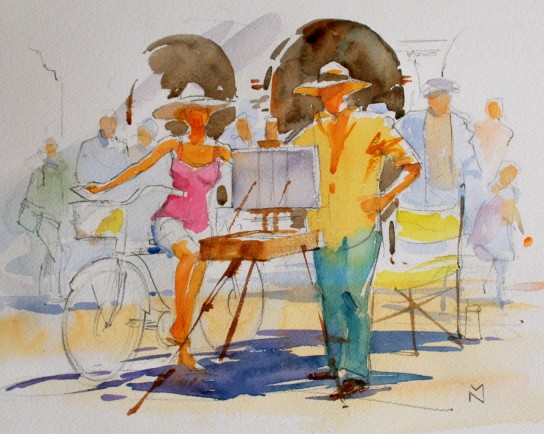I began to lay-in something new in the studio over the weekend, a painting constructed from painted studies and my own imagination/recollections. Very liberating and fun after my last outdoor piece, which required a lot of physical effort and direct response to natures’ quirky comings and goings, what I call “chasing the light” for lack of a better description.
Most every plein-air sketch painted after the sun begins to wane will suffer from an under-exposed look. The darks, when later viewed in normal light, will appear weaker than you painted them and there can be a bit of a washed out, timid look to the color, which is simple to understand because in those circumstances the artist is making decisions while painting in what amounts to a darkening studio.
If you want to understand this better, go into a dining room with one of those dimmer switches on the overhead light. Look at a white object, say a dinner plate, in full light on the table and then gradually begin to turn the light down 30%. The white object is still a white object, but it’s not white anymore, it’s a gray of some sort, and 30% darker from where you started. So are all the other tones. This is going in the direction of low-key painting, where the lightest lights and subsequent supporting tones are all subdued, the edges soften, and the darks cluster into shapes and silhouettes.
For that reason, it’s important for me to study the effects of early evening light with the idea that I’ll be replicating them mostly from memory later.
untitled, 18 x 24″, hand-primed linen mounted on panel
I have a number of small early-evening sketches that are adequate to remind me of the effect I want in this painting, but I know I can’t rely on them completely. So, for this piece I get to dream and recall those precious times alone after I finish working outdoors on a late afternoon piece, when my light effect is gone and energy spent, and I’m just in that envelope of late-dayness, where you finally put everything aside and you are simply glad to be there.
The composition itself is a collection various experiences cobbled together, a tree or two from one place, a cliff from another. Let’s just keep that between ourselves, though.
I foresee thin and thick paint built up in quiet shape-touches of broken color for this. A rich surface. I hope I can do it, and I hope it will be beautiful.











 Untitled, watercolor 11 x 15″
Untitled, watercolor 11 x 15″ 
 Parthenon cast, oil 22 x 24″
Parthenon cast, oil 22 x 24″ The Man
The Man 





